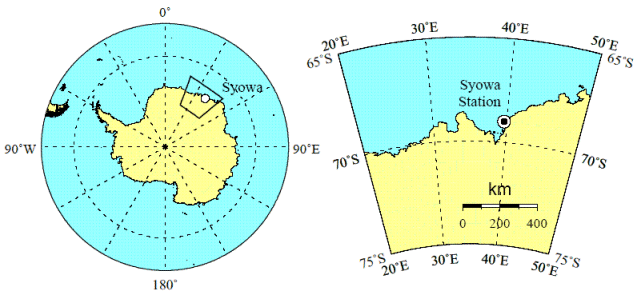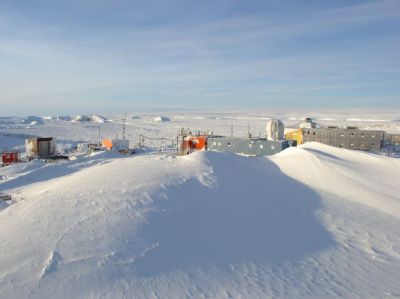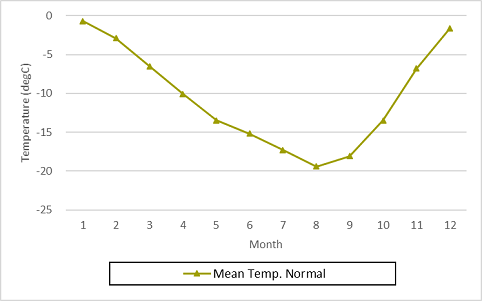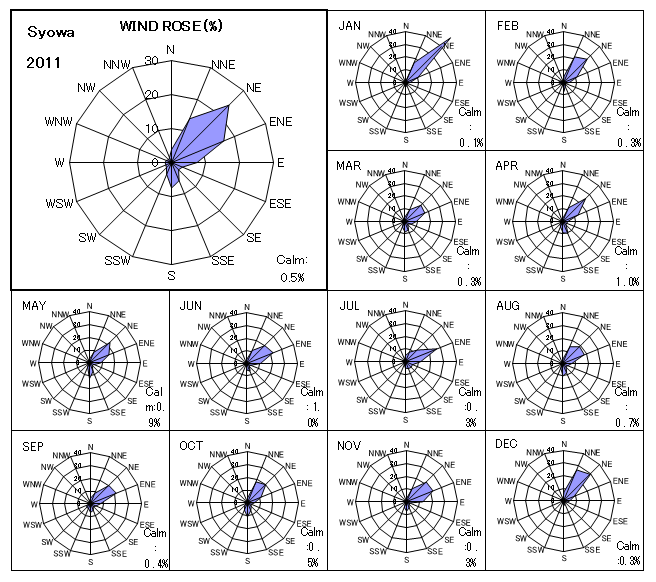Observation station for greenhouse gases (Syowa)
In Syowa Station, the Japan Meteorological Agency (JMA) observe the atmosphere density of Surface ozone at the part of the Global Atmosphere Watch (GAW) programme of the World Meteorological Organization (WMO). Please refer to "Observation stations for greenhouse gases" for the observation of the JMA in the GAW programme.
Syowa (SYO)
Antarctic Syowa Station is located on East Ongul Island, which is 4 km apart westward from the Antarctic ice edge at the east side of Lutzow-Holm Bay (Figure 1). The station is situated north of East Ongul Island, and is deployed in an area with an east-west length of about 1.5 km and a north-south length of about 1 km. The main part of the station consists of a management building and residential building complex; the meteorological building is located about 100 m west of the management building. Northeastern winds prevail at Syowa Station all year round; therefore, the effect of pollution is miniscule, except only for possible temporary anthropogenic pollution caused by station activities in summer. Table 1 lists the observation parameters and systems used at Syowa Station. Issues related to the observation of the ozone layer and UV radiation are discussed here.
|
Figure 1: Location of Syowa station |
|
Figure 2: Bird's eye view of Syowa |
|
Table 1: Observation parameters, frequency and instruments at Syowa |
| Parameter | Observation start | Frequency | Instruments |
|---|---|---|---|
| O3 | Jan. 1997 | Continuous |
UV Ozone Monitor
Dylec Inc. MODEL1100(*1) (Jan. 1997 - Jan. 2010) EBARA JITSUGYO CO.,LTD. EG-3000F(*2) *Replaced (*1),(*2) every two years (Feb. 2010 -) |
| Aerosol optical depth | Jan. 1980 | Continuous |
Sunphotometer
EKO INSTRUMENTS CO.,LTD. MS-110 (Jan.1980 - Jan. 2011) PMOD/WRC Precision Filter Radiometer (Feb. 2011 -) |
Climate
Climatically, being far away from other continents, Syowa Station is not significantly affected by katabatic winds, is relatively warm (annual mean temperature in a normal year (1981–2010): -10.5 °C) compared to other stations in Antarctica, has relatively gentle wind (annual mean wind speed: 6.5 m/s) , and is classified as being in the coastal weak wind zone. The station is located in the Antarctic Circle, and the nights start in late May, and the sun does not appear until mid July. The period of the midnight sun starts early November and ends in mid January. The highest temperature ever recorded is 10.0 °C, and the lowest is -45.3 °C. A developed low pressure system brings strong winds and snowfall as it is approaching, resulting in blizzards. There are about 27 blizzards annually with a total of over 51 blizzard days on average. The maximum wind speed and maximum instantaneous wind speed recorded are 47.4 m/s and 61.2 m/s, respectively; the number of days of snow annually is 191 days on average, with snowfalls throughout the year, with 10 or more days of snow monthly even during the midnight-sun months of November to January.
|
Figure 3: Monthly normal temperature at Syowa |
Figure 4 indicates wind rose of annual / monthly mean wind velocity at Syowa in 2011. Wind direction is dominant between north-northeast and east-northeast, annual mean wind speed was 6.7 m/s.
|
Figure 4: Wind rose of annual / monthly mean wind velocity at Syowa in 2011 |
References
Information of another observation station for greenhouse gases



